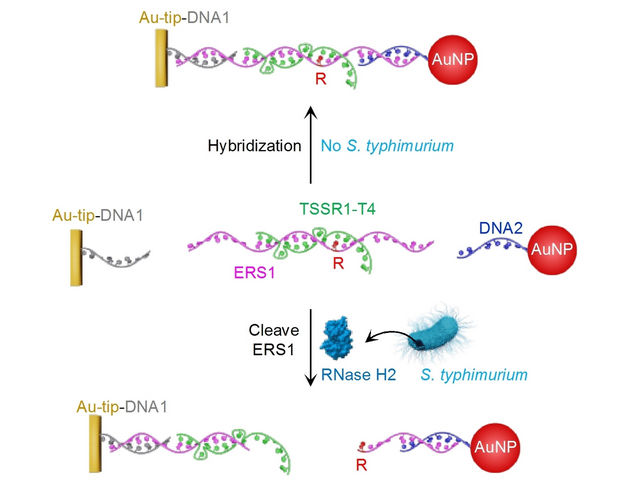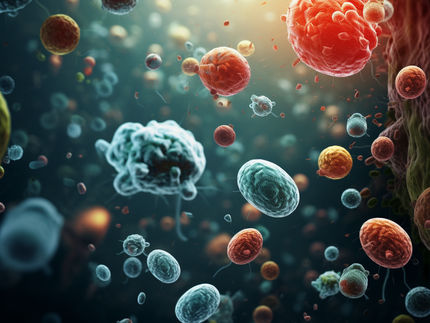Salmonella Detection
Simple Colorimetric Sensor Rapidly Detects Food Contamination Using a Nucleic Acid Probe
A team of researchers have developed an easy-to-use colorimetric assay for the detection of food contaminated with salmonella. The assay is based on a novel nucleic acid probe that is cleaved by an RNase enzyme specific to the salmonella species. As the team report in the journal Angewandte Chemie, this specific enzymatic cleavage principle made it possible to build a sensitive but simple and portable test system using colloidal gold.

© Wiley-VCH
Consumption of food contaminated with Salmonella typhimurium, whether eggs, ground meat, or chicken, can lead to severe food poisoning. However, suspected cases of salmonella are usually only confirmed several days later, when the bacteria are detected in microbiology laboratories by growing them in culture. A team of researchers led by Yingfu Li, Tohid Didar, and Carlos Filipe of McMaster University in Hamilton, Canada, have now developed a novel test system based on a hybrid DNA-RNA probe that specifically and rapidly detects salmonella, without the need for microbiological diagnostics or expensive analytical equipment.
Using a multi-round selection process, the McMaster team uncovered an artificial DNA-RNA hybrid probe that is a substrate for a salmonella-specific form of an RNase H enzyme. Based on this highly specific enzymatic recognition, the team first developed a fluorescence-based assay on salmonella RNase H, and then extended the principle to a simple, portable salmonella assay based on a colloidal gold colorimetry.
Colloidal gold is a common color reagent familiar to many of us from its use in SARS-CoV-2 antigen test strips. In a slight departure from this methodology, however, the team did not use a paper strip as the basis for their assay, but instead turned to plastic pipette tips, which are commonly used in the laboratory to measure specific amounts of liquids.
For the preparation of the colorimetric assay, the inner wall of a pipette tip was first coated with DNA-functionalized nanogold. A mixture of reagents composed of nanogold-DNA and the DNA-RNA probe were then sucked up into the pipette tip, causing a double layer of nanogold to form on the walls, because the DNA-RNA hybrid probe links both layers.
However, when the sample mixture contains salmonella, the upper layer is released thanks to the salmonella RNase H specifically cleaving the DNA-RNA linker probe. When the gold-containing solution is then drained onto an absorbent pad with a nylon membrane, a clear red spot indicates the presence of salmonella in the sample being tested. The team also tested the specificity of their system, finding it did not falsely detect the presence of other bacteria containing RNAse H.
The authors highlight that the test is not only much less complex than other methods for detecting salmonella, but also much faster. In contrast to other methods, only one hour of incubation in a pipette tip is required for highly sensitive detection of salmonella, for example, in ground beef. In the future, the team envision developing more nucleic acid probes which can specifically detect other infectious pathogens, for example coliform bacteria such as E. coli.
Original publication
Other news from the department science

Get the analytics and lab tech industry in your inbox
By submitting this form you agree that LUMITOS AG will send you the newsletter(s) selected above by email. Your data will not be passed on to third parties. Your data will be stored and processed in accordance with our data protection regulations. LUMITOS may contact you by email for the purpose of advertising or market and opinion surveys. You can revoke your consent at any time without giving reasons to LUMITOS AG, Ernst-Augustin-Str. 2, 12489 Berlin, Germany or by e-mail at revoke@lumitos.com with effect for the future. In addition, each email contains a link to unsubscribe from the corresponding newsletter.
























































